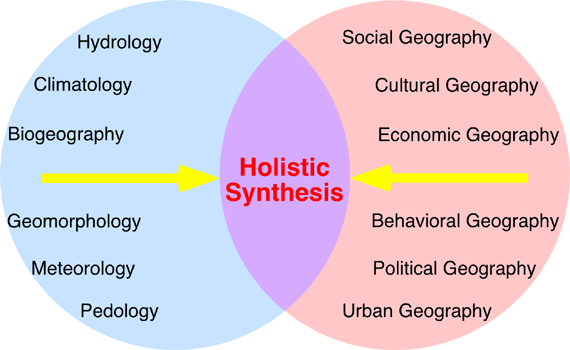In the previous section, we discovered that geography consists of at least two different sub-fields of knowledge with similar methodology: Physical geography and human geography. The following table also helps to make the differences between these two types of geography more apparent. This table describes some of the phenomena or elements studied by each of these sub-fields of knowledge. Knowing what kinds of things are studied by geographers provides us with a better understanding of the differences between physical and human geography.
Table 1b-1: Some of the phenomena studied in physical and human geography.
Physical Geography |
Human Geography |
Rocks and Minerals |
Population |
Landforms |
Settlements |
Soils |
Economic Activities |
Animals |
Transportation |
Plants |
Recreational Activities |
Water |
Religion |
Atmosphere |
Political Systems |
Rivers and Other Water Bodies |
Social Traditions |
Environment |
Human Migration |
Climate and Weather |
Agricultural Systems |
Oceans |
Urban Systems |
Geography is also a discipline that integrates a wide variety of subject matter. Almost any area of human knowledge can be examined from a spatial perspective. Figure 1b-1 describes some of the main subdisciplines within human and physical geography. Physical geography's primary subdisplines study the Earth's atmosphere (meteorology and climatology), animal and plant life (biogeography), physical landscape (geomorphology), soils (pedology), and waters (hydrology). Some of the dominant areas of study in human geography include: human society and culture (social and cultural geography), behavior (behavioral geography), economics (economic geography), politics (political geography), and urban systems (urban geography).

Figure 1b-1: Major subdisciplines of physical and human geography. |
The graphic model in Figure 1b-1 indicates that the study of geography can also involve a holistic synthesis. Holistic synthesis connects knowledge from a variety of academic fields in both human and physical geography. For example, the study of the enhancement of the Earth's greenhouse effect and the resulting global warming requires a multidisciplinary approach for complete understanding. The fields of climatology and meteorology are required to understand the physical effects of adding addition greenhouse gases to the atmosphere's radiation balance. The field of economic geography provides information on how various forms of human economic activity contribute to the emission of greenhouse gases through fossil fuel burning and land-use change. Combining the knowledge of both of these academic areas gives us a more comprehensive understanding of why this serious environmental problem occurs.
The holistic nature of geography is both a strength and a weakness. Geography's strength comes from its ability to connect functional interrelationships that are not normally noticed in narrowly defined fields of knowledge. The most obvious weakness associated with the geographical approach is related to the fact that holistic understanding is often too simple and misses important details of cause and effect.